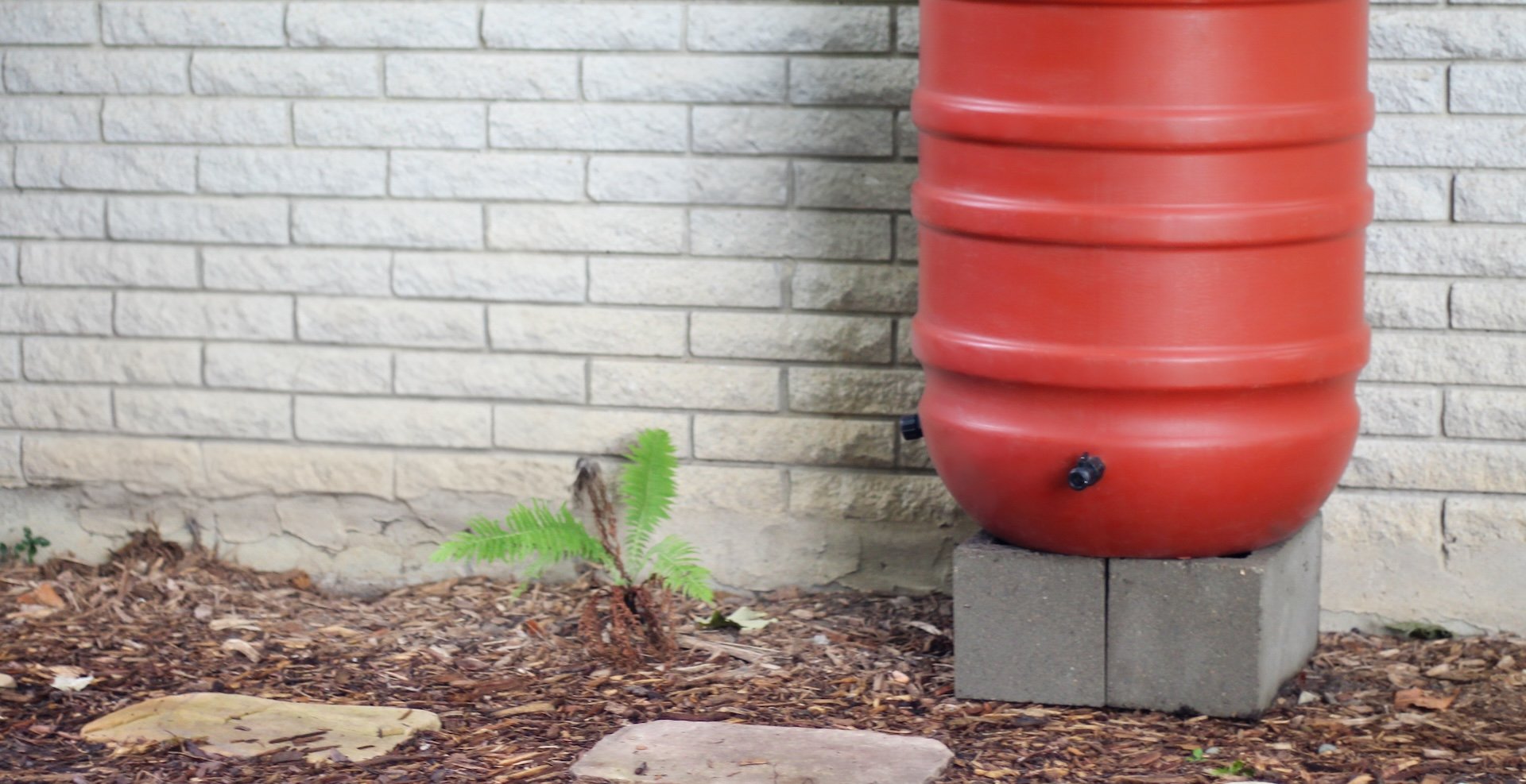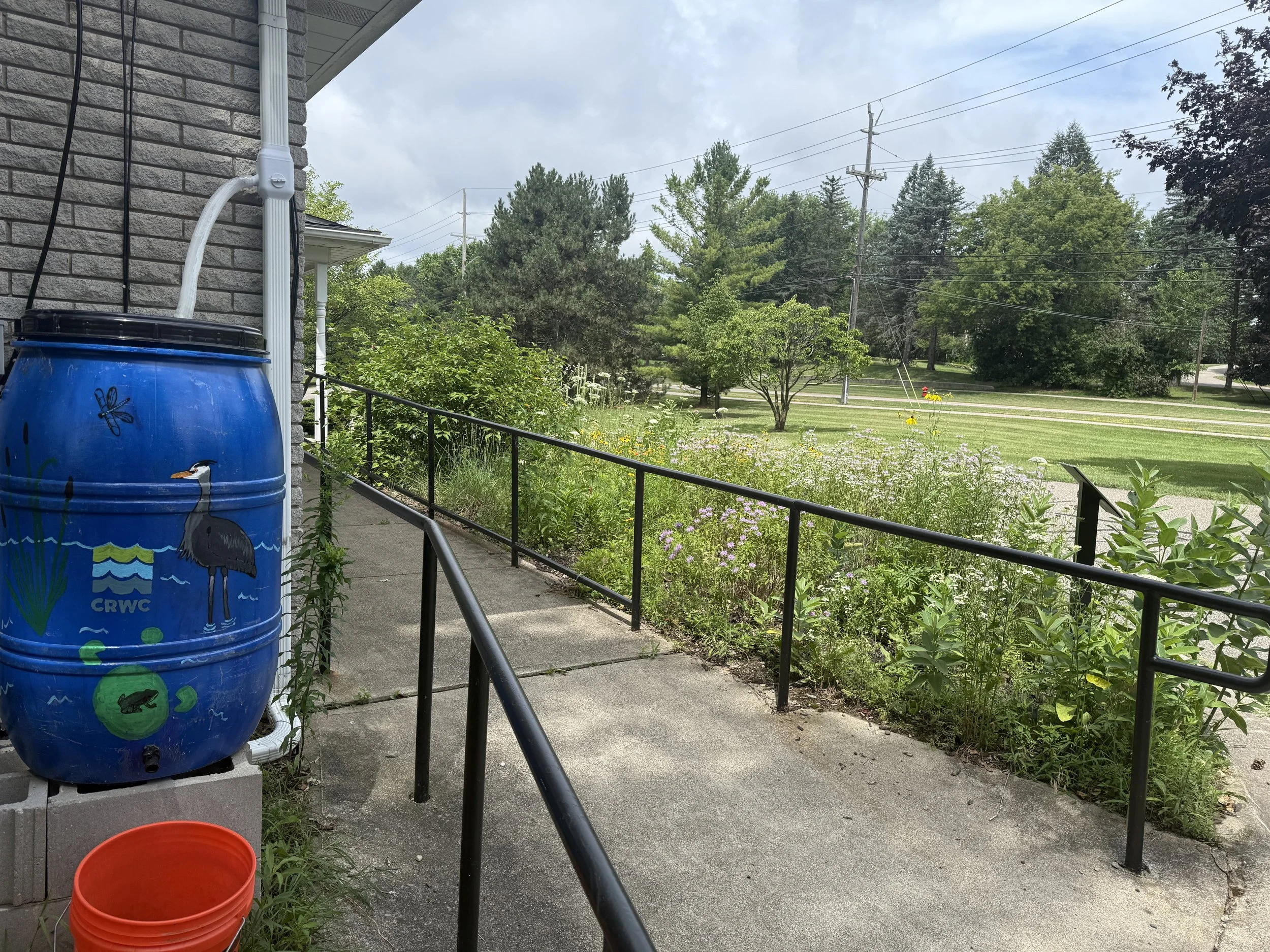
Rain Barrels
WHY RAIN BARRELS?
Rain barrels connect to the downspout of a house, garage, or other structure to collect and store rainwater runoff from your roof. Using a rain barrel helps reduce the amount of stormwater entering storm drains and local waterways, which helps decrease pollution, erosion, and flooding.
Rain barrels are an excellent way to conserve rainwater and reduce water bills while benefiting the environment. By collecting rainwater, you can effectively harvest nature's gift and utilize it for various household and outdoor needs. Rain barrels help reduce the demand on municipal water supplies, especially during dry seasons, by collecting and storing rainwater for later use.
When rainwater moves over impervious surfaces like rooftops and driveways, it can collect pollutants and carry them directly into local lakes, rivers, and streams. By capturing rainwater that would otherwise run off into storm drains, rain barrels mitigate the risk of flooding and prevent pollutants from entering local waterways.
BENEFITS AND USE
REDUCES FLOODING & POOLING
CONSERVES WATER FOR DRY PERIOD/DROUGHTS
LOWERS UTILITY BILLS & SAVES WATER
REDUCES POLLUTION BY REDUCING STORMWATER RUNOFF
PROVIDES BETTER WATER FOR GARDENING
Installing a rain barrel offers several environmental and practical advantages. Utilizing rainwater for activities such as watering gardens, lawns, and washing cars can lead to substantial savings on water bills, particularly during peak usage periods.
*Rainwater is not potable unless properly filtered and disinfected. Avoid using rain barrel water in direct-contact uses such as for drinking water, kiddie pools, and/or bathing animals. Roof-collected rainwater can contain contaminants like bird droppings, bacteria, microorganisms, or roofing materials that may not be safe for edible plants. If you’re interested in using rain barrel water for vegetable gardens, Watersafe test kits are available for purchase online.
RAIN BARRELS BY THE NUMBERS
55
Gallon Capacity
200
Square feet of roof draining into the barrel
~45
Rain Events (May - Oct.)
2,500
Gallons Saved per Season
WHERE TO INSTALL A RAIN BARREL
When choosing a location to install a rain barrel, it is important to consider convenience, ease, and practicality. As you assess your property, ask yourself the following:
Is there an area on your property where water tends to pool or cause erosion?
Rain barrels can help manage stormwater in these problem areas. They have the greatest impact when water is routed directly from the downspouts to collect roof runoff.
Is the area clear of pre-existing objects? Is there enough space?
Check the area for utilities, spigots/hoses, AC units, PVC pipes, or wires. A rain barrel requires 2 feet by 2 feet of space, and is typically installed next to the foundation of the house or garage. Routing the water from the downspout through a diverter or flex elbow allows for some distance from the foundation, but it is important to measure spacing before finalizing the desired location.
Do you regularly use water outdoors?
Watering your lawn, garden, or landscaping or washing your car, patio, or tools is a great way to use rain barrel water.
Is the area near the downspout flat and level?
A stable base is important for the barrel. Driveways, sidewalks, and other evenly paved surfaces are great locations for rain barrels.
Is the location for the rain barrel easy to access?
It’s important to select a location that can be regularly accessed for ease of using rain barrel water, proximity to watering locations, and for maintenance procedures such as cleaning and winterizing. Avoid tight, hard to reach, and overly grown-in spaces.
Can the water safely overflow away from housing structures?
An overflow hose is necessary when routing water through a flex elbow. The overflow hose should be directed away from the house.
RAIN BARREL MAINTENANCE AND CARE
Proper seasonal maintenance will help extend the life of your rain barrel and ensure it functions effectively when in use.
-
Rinse out any debris or sediment that may have built up over the winter.
Check the spigot and other fittings for tightness or damage.
Reinstall the rain barrel on its stand by reconnecting the diverter or flexible elbow to the rain barrel.
-
Use collected rainwater within a few days of each rainfall to prevent mosquito breeding and algae growth.
Regularly check the mesh screen and downspout diverter for leaves and other debris.
Clear all debris from downspouts and gutters to maintain good water flow into the barrel.
-
Clear any leaves or debris from the diverter and mesh screen.
Drain the rain barrel completely by late October or upon the first freeze.
Disconnect the hose from the diverter and flip the diverter to the “open” position so water bypasses the barrel. For a flex elbow, reattach the bottom of the downspout.
Clean the barrel with mild soapy water and a soft cloth.
Store the barrel upside down in a dry location such as a garage or basement. The rain barrel may also be left outside, as long as it is flipped upside down and water cannot enter.
INSTALLING A RAIN BARREL
If you want to learn a little more about the installation process, check out the video below. We use an individually sourced food-grade barrel, metal fittings, a downspout diverter, hoses, and common tools to assemble a rain barrel without using a kit. CRWC collaborated with Oakland County Water Resources to produce this rain barrel installation video.
INSTALLATION MATERIALS
(PER RAIN BARREL)
(1) Standard 55 gallon food grade rain barrel
(8) Cinder blocks (or wood stand 6-18” off of the ground)
(1) Downspout diverter (with adjustable valve and routing hose) or flex elbow
(1) Hack saw for cutting into the downspout.
Eye/ear protection
Diverter
OPTIONAL INSTALLATION MATERIALS
(1) Tin snips
(1) Trowel for removing sod/soil
(1) Pack of gutter screws (optional) - securing diverter to downspout
(1) Bag of pea gravel for leveling
*Pea gravel and trowels are not necessary if the rain barrel is placed on pre-existing pavement
ROUTING WATER: DIVERTER VS FLEX ELBOW
Flex Elbow
All water from the downspout is routed into the barrel.
When the rain barrel is full, water may overflow from the top of the barrel if the overflow hose is overwhelmed.
The bottom of the downspout needs to be reattached for winterizing the rain barrel.
Easy to manage water flow going into the barrel.
Allows homeowner to stop routing water into the rain barrel if/when full.
Easy for winterizing (see maintenance and care)
WINTERIZING A RAIN BARREL
Be sure to winterize your rain barrels before the first frost of the season. Learn the steps to prepare your barrels for winter.
ANATOMY OF A RAIN BARREL
Rain barrels consist of a variety of parts, and can be put together in several different ways. Our example diagram is a single rain barrel that uses a flexible elbow. You can certainly build your own rain barrel using a food-grade barrel and parts from a local hardware store, OR you can purchase a pre-fabricated rain barrel kit during our sale in the spring or fall.
A standard rain barrel system typically includes the following features:
Rain barrel: 50+ gallon barrels are ideal. Avoid using clear containers as they are more likely to promote algae growth.
Inlet with mesh screen: located on the lid, this is where rainwater enters the barrel. The mesh screen helps filter out leaves, insects, and other debris, while also deterring mosquitoes.
Overflow outlet: allows excess water to safely exit the barrel during heavy rain events, preventing overflow near the base. The overflow hose that connects to this outlet should be directed away from your house/garage and away from property lines.
Spigot: positioned near the bottom of the barrel, it provides access to the stored water and allows connection to a hose or watering can.
Elevated base: a stable, level platform raises the barrel to improve water pressure and make it easier to fill containers from the spigot. The base is generally made up of either cinder blocks or a wood stand.
FREQUENTLY ASKED QUESTIONS (FAQS)
-
Having a screen over your rain barrel will help prevent mosquitoes from getting in and laying eggs. Adding small rocks or gravel on top of the rain barrel lid will let water enter the barrel while filtering most insects and debris. You can also buy a mosquito control tablet with BTI– a naturally-occurring bacteria that targets mosquito larvae. BTI is harmless to plants, animals, and people.
-
No, it is unlikely that there will be enough water pressure for more than a slow stream out of a hose attachment. There are water pressurizers available online that can link to the rain barrel to pressurize the water output for a hose. Otherwise, the water pressure relies on gravity and fullness.










